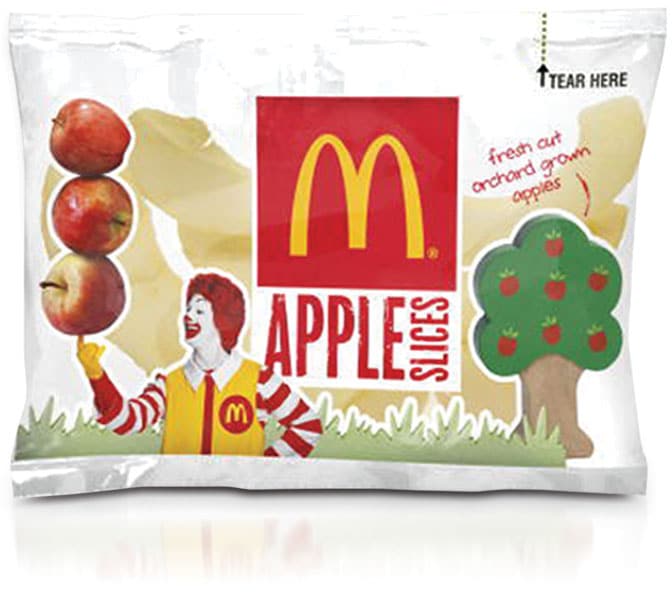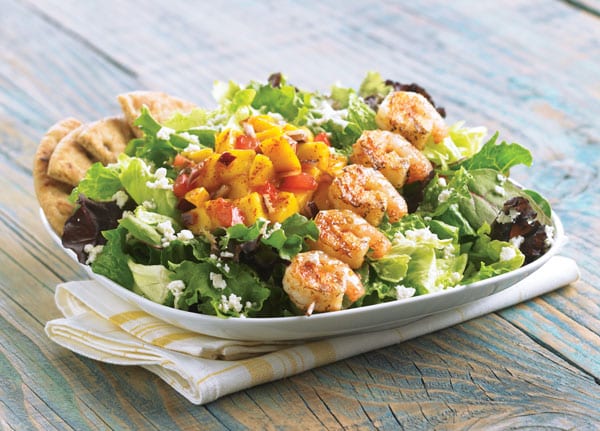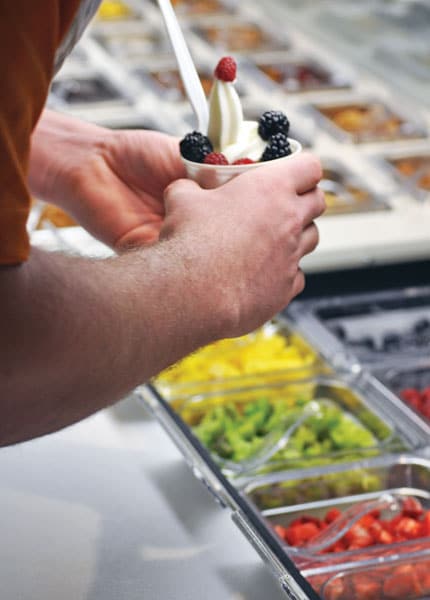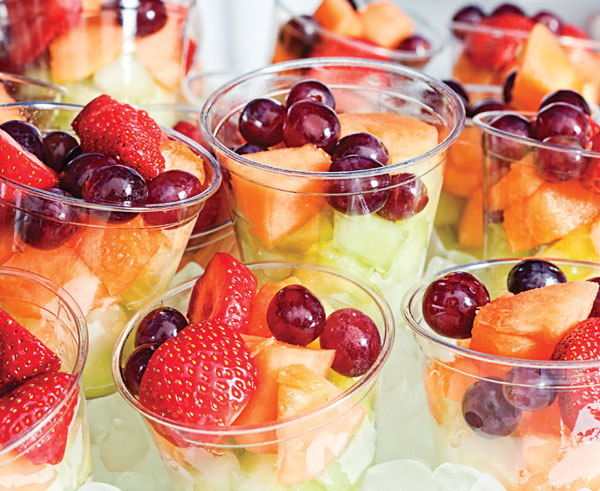Walking into some quick-service restaurants these days can make you feel like you’ve just wandered into the produce section at Whole Foods. A colorful cornucopia of fresh fruit—from deep-yellow mangos and light-green apples to purple pomegranates and ruby-red strawberries—is getting highlighted in every menu category. Fruits from across the world are showing up in breakfast items, as part of eye-catching salads, as accompanying elements to entrees, as fresh-pressed beverages, and as healthy dessert options.
This fruit usually travels a long and complex road from the orchards, fields, and groves to a quick-service chain’s multiple outlets. Ensuring that consumers get a fresh product can be difficult, so operators use a variety of tactics to maximize that freshness and extend its window of usage. Given the scale of use—Wendy’s alone uses more than 750,000 pounds of fresh fruit per week on its offerings—operators are trying to make their fruit processes as efficient as possible.
Some operators rely on fruit that is picked prematurely so that it ripens in transit, a process that can often take weeks. Others employ the individually quick frozen (IQF) technique to flash-freeze fruit and lock in its consistency, flavor, and freshness. Still others use a variety of chemicals to help extend freshness. Sourcing location, prepping approaches, and storage methods also play a role. All of these strategies inherently help cut down on spoilage and moisture loss, which can be a major cost when using fresh produce with a limited shelf life.
A number of high-profile quick-service chains have begun incorporating fresh fruit into their menus. Wendy’s, Chick-fil-A, and Panera Bread have all worked fresh fruits into their salad offerings; Arby’s offers sliced apples as a part of its kids’ meals; Saxbys Coffee uses fresh fruit on frozen yogurt and in made-to-order smoothies; and Corner Bakery utilizes fruit in a variety of menu items, including several salads that highlight fresh fruit.

One concept making a big splash with its fresh fruit offerings is a quick-service chain best known for burgers and fries: McDonald’s. Whether kids order a Happy Meal with a hamburger, a cheeseburger, or Chicken McNuggets, they now are always going to get a 1.2-ounce vacuum-sealed bag of apple slices to complement it. (The price of the Happy Meal will remain the same.) Apples were chosen after McDonald’s market research consistently demonstrated that it was consumers’ favorite fruit, so the chain uses a number of varietals, including Granny Smith, Gala, Jonagold, Golden Delicious, and Empire.
Though the company has been offering a larger portion of the apples as an add-on since 2004, it became a standard element in Happy Meals earlier this year. Research conducted by McDonald’s showed that while 88 percent of consumers were aware of the apples’ availability, only 11 percent ultimately ordered them.
“McDonald’s wants to help support parents in encouraging their children’s habit of eating produce at meals,” says McDonald’s USA’s family category marketing director, Molly Starmann. “By automatically including them, McDonald’s is offering parents and kids a balance of the foods that are good for them along with the foods they love.”
It was an exhaustive, multiyear effort to get these apples out of the orchards and into the classic red-and-yellow Happy Meal boxes. It took the company several years to simply get its suppliers to grow enough trees to accommodate the company’s expansive needs. Starmann estimates that this newly implemented program will serve up to 100 million cups of fresh apples this year alone at the company’s 14,000 stateside outlets. McDonald’s is sourcing its apples primarily from Washington, California, New York, and Michigan, though it does use apples imported from Chile, as well.
It’s part of the company’s broader health initiatives targeted at younger consumers, dubbed the “Commitments to Offer Improved Nutrition Choices” campaign. “McDonald’s has consulted with nutrition experts, while also working with our supplier partners, owner/operators, and our menu development teams to invest in ongoing menu evolution efforts, as well as nutritional communications,” Starmann says.
The apple addition also speaks to the restaurant’s larger goal to offer more fresh fruits, including blueberries and strawberries, to consumers in a variety of items. Customers now have the opportunity to order Real Fruit Smoothies, Fruit & Maple Oatmeal, a Fruit & Walnut Salad, and a Fruit & Yogurt Parfait.
“While we can’t share specific sales data or volume information, we can say that many of our new menu items with fruit are very popular among a wide variety of our customers,” Starmann says.

Oftentimes restaurants will use a limited-time offer as a way to test just how fresh fruit would work into their system and how consumers will react to it as part of their brand offerings. In 2011, after Daphne’s Greek Café changed its positioning to become Daphne’s California Greek, it used this strategy to incorporate fruit.
“The California orientation toward freshness opened the window for new items on the menu,” says Karen Gorrell, a culinary consultant for the National Mango Board who worked with Daphne’s to develop new menu items. “That led the way to new ingredients that hadn’t previously been appropriate for the brand.”
Daphne’s ultimately developed a fresh mango salsa, which was a part of the LTO Mango and Shrimp Salad. It then worked with Gorrell and her colleagues to learn how to best handle the fruit to ensure that it enjoyed the maximum shelf life in the store, which would lead to the lowest amount of product loss due to spoilage. Gorrell estimates that fresh mango has about a seven-day window of opportunity for use.
Next: Pinkberry introduces new kinds of fresh fruit to their customers.
[pagebreak]
Gorrell works with quick-service restaurants and suppliers to determine the best way for the mangos to arrive in stores. “You can buy them ripe-ready, fresh, pre-cut, or whole,” Gorrell says. “Or quick-service restaurants can simply buy the cheeks without the seed at the center, so they can slice or dice it according to their need.”
When a restaurant finds a fresh fruit that fits well with its brand, the results can be a win-win for suppliers and operators. The Mango and Shrimp Salad was initially offered for three months at the beginning of this year, but it was so successful that Daphne’s extended its availability for an additional three months through the end of the summer. “We hope that it will turn into a long-term menu application or a recurring seasonal application,” Gorrell says.
When it comes to a quick-service restaurant constantly introducing new fresh fruits to its customers, Pinkberry is an industry leader. The frozen yogurt chain offers an average of eight fresh-fruit toppings at any given time in each of its retail outlets, with four to eight new fresh-fruit toppings being switched in annually.
Some fruits are only available in a single region. When Pinkberry recently opened in Peru, the advance team discovered the lucuma, a native fruit with a flavor similar to pumpkin. The local operators use it as a flavoring agent for an exclusive yogurt, and also include fruit toppings like strawberries, pineapple, and bananas. “We pride ourselves in being the curators of fruit,” says Pinkberry’s senior vice president of marketing and design, Laura Jakobsen. “While many people are mainstream with their fruit, we also want to create the excitement of discovery by bringing people to fruits for the first time.”

“One of our values is uncompromising quality and we will not compromise on the quality of the fruit,” says Pinkberry CEO Ron Graves. “We look for the best fruit in season that’s at the perfect ripeness. Even if it’s in season, you can have fruit that’s too ripe or not ripe enough, which can have an impact on the quality.”
“Freshness is our business,” Jakobsen says. “Our topping bar is our customization and our customer delight factor.”
In order to accommodate all 175 stores located in 17 countries, Pinkberry relies on an international network of fruit suppliers. Depending on location, season, and availability, an outlet will receive a mixture of locally, domestically, and internationally sourced fruit. “We aren’t committed to an inflexible supply chain system,” Jakobsen says. “There are guardrails and parameters that stay consistent, but there’s flexibility so we can accommodate the sourcing of local fruit. We want to make sure that there’s a short chain between when we source it and when it’s available in store.”
Whole fresh fruit arrives daily at locations. “It’s never frozen, never in syrup,” Graves says.
Topping specialists travel to each new outlet to train employees how to properly cut the different fruits. “It all ultimately looks like little jewels,” Graves says. “They’re not randomly cut.” Once it’s prepped, the staff constantly monitors the fruit to ensure that it is only available for use during its peak freshness.
Maintaining fresh flavor is a core philosophy for Evolution Fresh. This quick-service restaurant with a focus on fresh juices and smoothies launched its first location in Seattle in the middle of March. It has an eye to expand exponentially after it has perfected its operations. And as far as setting up sourcing and supplying practices, it has a not-so-minor factor in its favor: it’s owned by Starbucks.
“Leveraging those relationships, we have the opportunity to call on any area of expertise possible,” says Arthur Rubinfeld, the company’s president of global development. “We’re drawing on their expertise in operations, product quality awareness, and driving into [consumer packaged goods].”
The company has a unique process that sets it apart from other juice-focused operations. “The main point of differentiation for us is that our juices are cold pressed, processed under pressure, and never heated,” Rubinfeld says. “So nutrients and enzymes are retained.”
For the juices dispensed from the patent-pending digital juice tap wall, the company has created a system to ensure maximum freshness: Fruit is processed into juice at facilities located right next to the farms where the fruit is grown. For example, its orange juice processing plant is in San Bernardino, California, next to the orchard that supplies the company. This cuts down on transportation costs and allows Evolution Fresh to ship the juice directly from this facility to its Seattle store. As the company expands beyond its flagship location, the sourcing will become exponentially more complicated, which is why Rubinfeld wants the company to grow at a reasonable rate to ensure a consistent level of quality across all its outlets.
Evolution Fresh is hoping to cut out a big slice of emerging sectors where fresh fruit is a key component. “The super premium juice business today is about a $1.6 billion industry,” Rubinfeld says. “The premium juice business is about $3.5 billion and health and wellness is about $50 billion, and that has been growing exponentially over the last few years.”
The overall fresh-fruit industry represents an even larger target market for quick-service operators. According to a study by the U.S. Census Bureau, Americans are now eating more fresh fruit than ever. Tracking between 1980 and 2009, research showed that the average consumer went from eating 106.2 pounds of fresh fruit annually to 127.5 pounds annually.
“The world is getting healthier and people want fresher foods,” Graves says. “That’s always a good thing.”
It looks like diners have a growing appetite for more than just an apple a day.











